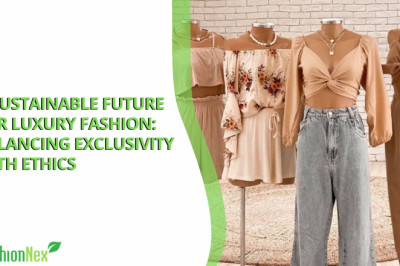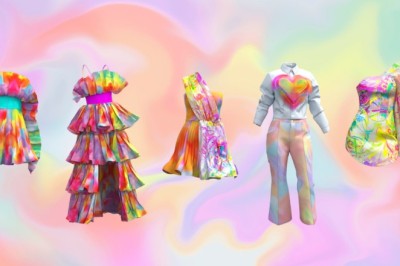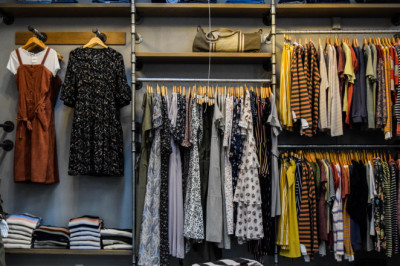views

Eco-Friendly Runway: Sustainable Styles Stealing the Spotlight
The fashion industry, once notorious for its environmental impact, is experiencing a transformative shift. As the world grows increasingly aware of the urgency of environmental sustainability, eco-friendly fashion is no longer a niche market but a burgeoning trend dominating the runways. This movement is not just about wearing clothes made from recycled materials; it encompasses a holistic approach to sustainability that includes ethical production, reducing waste, and promoting mindful consumerism. Here's a deep dive into how sustainable styles are stealing the spotlight on the eco-friendly runway.
The Rise of Sustainable Fashion
Sustainable fashion is driven by a combination of consumer demand, innovative design, and ethical considerations. More consumers are seeking transparency in how their clothes are made, favoring brands that prioritize environmental responsibility and ethical labor practices. This shift in consumer behavior is prompting designers and brands to rethink their approaches, integrating sustainability into every aspect of their business models.
Innovative Sustainable Materials
One of the most significant changes in sustainable fashion is the development and use of innovative materials. Traditional textiles such as cotton and polyester are being replaced or supplemented with eco-friendly alternatives. For instance, organic cotton, grown without harmful pesticides, reduces water usage and soil degradation. Similarly, materials like Tencel, made from sustainably sourced wood pulp, offer a biodegradable alternative to synthetic fibers.
Recycled fabrics are also gaining popularity. PET bottles are being transformed into polyester fabrics, reducing plastic waste. Additionally, advancements in biotechnology are leading to the creation of lab-grown leather and silk, which minimize animal harm and reduce environmental footprints.
Ethical Production Practices
Sustainable fashion is not just about the materials but also about how clothes are made. Ethical production practices ensure that workers are paid fair wages and work in safe conditions. Brands are increasingly adopting fair trade practices and partnering with factories that uphold high labor standards. This ethical approach extends to supply chain transparency, where brands disclose their sourcing and manufacturing processes, allowing consumers to make informed choices.
Reducing Waste
The fashion industry is notorious for its waste, with millions of tons of clothing ending up in landfills each year. Sustainable fashion aims to tackle this issue through several strategies:
-
Circular Fashion: This concept involves designing products with their entire lifecycle in mind, ensuring that they can be reused, recycled, or composted. Brands are creating clothes that are not only durable but also designed for easy disassembly and recycling.
-
Upcycling and Recycling: Upcycling involves creatively reusing materials to create new products, giving old items a new lease on life. Recycling, on the other hand, involves breaking down products into raw materials to be used in new products. Both methods significantly reduce waste and conserve resources.
-
Zero-Waste Design: Designers are adopting zero-waste patterns, where fabric scraps are minimized or eliminated. Techniques like digital pattern making and 3D knitting help in achieving zero-waste goals by ensuring precise use of materials.
Promoting Mindful Consumerism
Sustainable fashion also focuses on changing consumer behavior. The rise of fast fashion has led to a culture of overconsumption, where clothes are quickly discarded for new trends. Sustainable fashion promotes mindful consumerism, encouraging consumers to buy less, choose quality over quantity, and consider the environmental impact of their purchases.
Spotlight on Sustainable Fashion Brands
Several fashion brands are leading the charge in sustainability, setting new standards for the industry. Here are a few notable examples:
-
Stella McCartney: Known for her commitment to sustainability, Stella McCartney uses organic cotton, recycled materials, and vegan leather in her collections. Her brand is also dedicated to ethical production practices and circular fashion principles.
-
Patagonia: A pioneer in sustainable fashion, Patagonia has long championed environmental responsibility. The brand uses recycled materials, offers a repair and reuse program, and donates a percentage of profits to environmental causes.
-
Eileen Fisher: Eileen Fisher’s brand is built on sustainability, using organic and recycled fibers, promoting fair trade, and implementing take-back programs to recycle old garments.
-
Reformation: This brand combines style with sustainability, using eco-friendly materials and practices. Reformation tracks its environmental footprint and offsets its carbon emissions, making sustainability an integral part of its business model.
The Role of Technology in Sustainable Fashion
Technology is playing a crucial role in advancing sustainable fashion. Innovations such as 3D printing, blockchain, and AI are revolutionizing the industry:
-
3D Printing: This technology allows designers to create garments with minimal waste, using only the necessary amount of material. It also enables the production of custom-fit clothing, reducing the need for mass production.
-
Blockchain: Blockchain technology ensures supply chain transparency, allowing consumers to trace the origins of their garments. This technology promotes accountability and helps combat unethical practices in the fashion industry.
-
Artificial Intelligence: AI is being used to optimize supply chains, predict fashion trends, and manage inventory efficiently. By reducing overproduction, AI helps minimize waste and supports sustainable practices.
Challenges and Future Directions
While sustainable fashion is gaining momentum, it faces several challenges. High production costs, limited availability of sustainable materials, and the complexity of supply chains can hinder progress. However, continued innovation, increased consumer awareness, and supportive policies can help overcome these challenges.
The future of sustainable fashion lies in collaboration and education. Brands, designers, consumers, and policymakers must work together to promote sustainable practices. Education initiatives can raise awareness about the environmental impact of fashion and encourage more sustainable choices.
Conclusion
The eco-friendly runway is not just a trend but a necessary evolution in the fashion industry. Sustainable styles are not only stealing the spotlight but also paving the way for a more responsible and ethical fashion future. By embracing innovative materials, ethical production, waste reduction, and mindful consumerism, the fashion industry can significantly reduce its environmental impact. As consumers, we play a crucial role in supporting this transformation by choosing brands and products that align with sustainable values. Together, we can ensure that the future of fashion is both stylish and sustainable.











Comments
0 comment